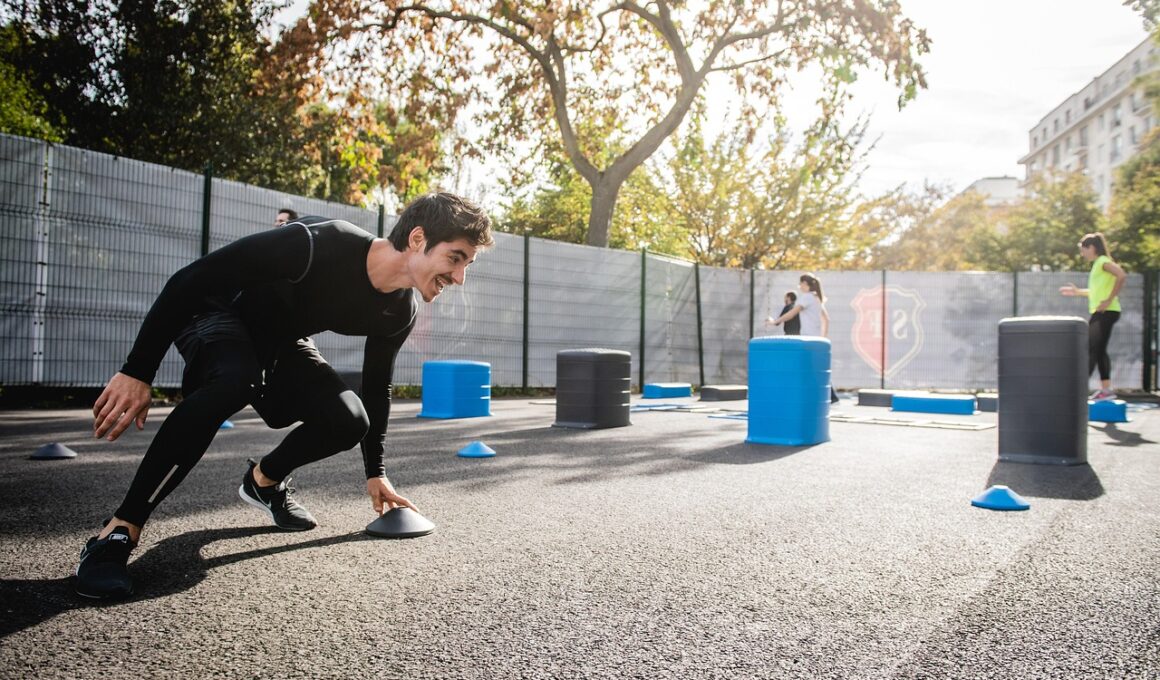Scaling Strategies for CrossFit Workouts in Hot and Humid Conditions
CrossFit workouts can be significantly challenging in hot and humid environments. Athletes might notice decreased performance due to factors like dehydration, fatigue, and heat-related illnesses. To address these challenges, scaling workouts becomes essential. Adjusting weights, reducing reps, and modifying exercises can help maintain the intensity without risking health. A focus on hydration before, during, and after workouts can mitigate some of these issues. It’s crucial to consume adequate fluids and electrolytes to replace losses from sweat. Additionally, workouts should be planned for cooler parts of the day when possible, such as early morning or late evening. Other strategies might include using lighter weights or performing exercises with less intensity. Always listen to your body, and don’t hesitate to reduce effort if feeling unwell. Consult with a coach if unsure about scaling options for specific workouts. They can help devise a strategy that optimizes performance while ensuring safety. Finally, remember that everyone is unique, and finding what works best for you may take some experimentation.
Understanding the Importance of Scaling
Scaling workouts properly in hot and humid conditions is essential for every CrossFit athlete. However, doing so goes beyond simply reducing weights or reps. It’s important to also consider the overall goal of the workout. For instance, if the workout emphasizes strength, it’s advisable to keep weights challenging, while possibly reducing repetitions for endurance-based workouts. Each workout should cater to your fitness level, ensuring that you maintain a consistent and effective training regimen. Incorporating intervals into your routine can help manage fatigue, allowing you to recover between intense sets. Understanding your limits is crucial. Pushing through extreme conditions can lead to injuries or heat exhaustion. Make warm-ups thorough but brief to avoid overheating. Remember that scaling is not an indicator of weakness but a strategy for maintaining health and performance. As you adapt to the heat, consider gradually increasing rehearsal intensity. This gradual acclimatization helps prepare your body for future workouts, protecting it from stressors. Moreover, communicate with your group about your preferences and scaling needs to foster support and camaraderie during challenging sessions.
As you implement scaling strategies, keep your nutrition in focus, especially in hot and humid conditions. Eating well plays a crucial role in how well you endure workouts. Prioritize hydrating foods like fruits and vegetables to stay refreshed and help offset fluid loss. Carry electrolyte-replenishing snacks, especially those high in potassium and sodium. Foods such as bananas, nuts, and electrolyte drinks can boost your performance dramatically. Pre-workout meals should be light yet substantial enough to provide energy. After workouts, replenish your glycogen stores with carbohydrates, combined with proteins, to promote recovery and muscle repair. Meals ideally should consist of lean proteins, whole grains, and healthy fats, ensuring you’re fueling your body correctly. Meal prepping for the week can reduce the likelihood of consuming convenience foods that may not serve your body well during humid conditions. Consult with a nutritionist to find a plan that accommodates your activity levels. An appropriate diet boosts performance and fat loss while helping to build muscle in the long term. By concentrating on good nutrition, you will elevate your overall training experience and results.
Utilizing the Environment
Hot and humid weather can significantly affect how you approach your CrossFit workouts. Embrace the environment by modifying your training location. For instance, consider moving workout sessions to shaded areas, indoors, or even utilizing fans for wind support during workouts. Performing exercises in water can also serve as a creative and refreshing approach. Circuit training in a pool or using water weights allows you to maintain workout intensity while keeping your body cooler. Be mindful of the heat and humidity levels, as well as acclimatization processes. Start with shorter duration workouts as your body learns to adapt to the intense weather conditions. Your performance will improve over time as you build a tolerance for heat. Always check the local weather before scheduling outdoor workouts and make appropriate decisions. Avoid outdoor workouts during peak sun hours, typically between 10 a.m. and 4 p.m. Focus on your warm-up and cool-down duration, ensuring you allow your muscles to acclimate gradually to avoid injury. Engage with your fellow athletes and adapt your environment collectively for safety and motivation during these conditions.
Integrating recovery days into your training program is vital when tackling workouts in challenging weather. Active recovery could help reduce muscle soreness while enabling your body to recuperate from the stress of workouts. Activities like yoga, stretching, foam rolling, or even gentle swimming can effectively relieve tension. Heart rates will remain lower during light activities while still keeping muscles engaged, promoting recovery. Additionally, pay attention to quality sleep, ensuring you get enough rest and restoration. In hot climates, consider conditions when training; extremely hot temperatures may compel you to alter rest periods length or switch to lower-intensity activities. Maintaining a consistent sleep schedule can also enhance your performance levels. Staying mentally fresh is just as important as physical readiness, especially during demanding workouts. Schedule regular time for relaxation or mindfulness to improve focus and mental resilience. Include mindfulness practices like meditation or simple breathing exercises, particularly in humid conditions where the stress level may be higher. This combination of physical recovery and mental awareness will facilitate growth during your CrossFit journey.
Community Support and Motivation
A supportive community is vital for succeeding with CrossFit workouts, especially in challenging climates. Engage with fellow athletes to share scaling strategies, encouragement, and motivation. CrossFit gyms often foster camaraderie that can lift your spirits on tough days. Participating in group workouts allows for complimentary scaling options, providing alternatives to complete difficult exercises based on individual capabilities. Encourage each other to stay accountable, reminding participants of hydration and rest among peers. Use social media platforms to connect with broader fitness communities and share experiences in humid conditions. Many athletes post scaling tips and workout modifications that can inspire others. Creating accountability and connection promotes a sense of belonging during challenging workouts. Consider seeking out workout partners who share similar goals and can push you to new limits. Modify each workout together or try new approaches; this can lead to incredible growth. Everyone benefits from the diversity of support, as you create different strategies to combat heat and conditions that hinder performance. Together, you’ll learn to adapt and thrive, improving both individual and collective fitness levels in any climate.
Ultimately, it’s crucial to remember that scaling CrossFit workouts in hot and humid conditions is not merely about reducing intensity; it’s about maintaining a balance that fosters health and performance. Finding the optimal combination of scaling, recovery, and nutrition enables you to combat the unique stressors posed by the environment. Continuously listen to your body and adjust strategies even within a single workout performance. Track your progress as you experiment with various strategies to determine what resonates with you the most. This approach allows continual adaptation and development over time. Celebrate small victories when you successfully tackle a challenging workout, and never shy away from changing your plan if necessary. Embrace the learning curve as a foundational part of your CrossFit journey, progressively adapting to challenges ahead. Stay resilient and grounded, remembering that every athlete has variations in capacity and experience levels. Maintain a growth mindset as you face each workout, understanding that scaling is a powerful tool. With the right mindset, nutrition, environment, and community, a fulfilling workout experience can happen anytime, anywhere—even in challenging heat.


